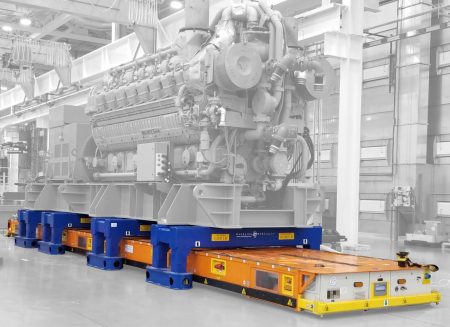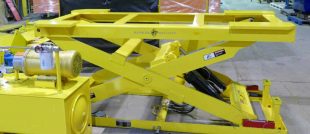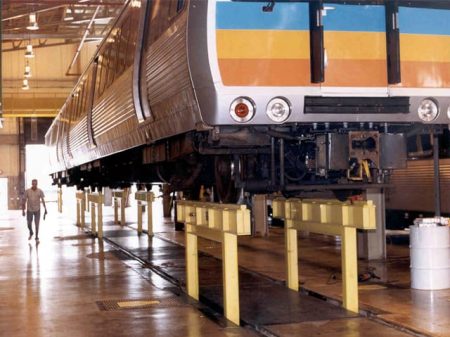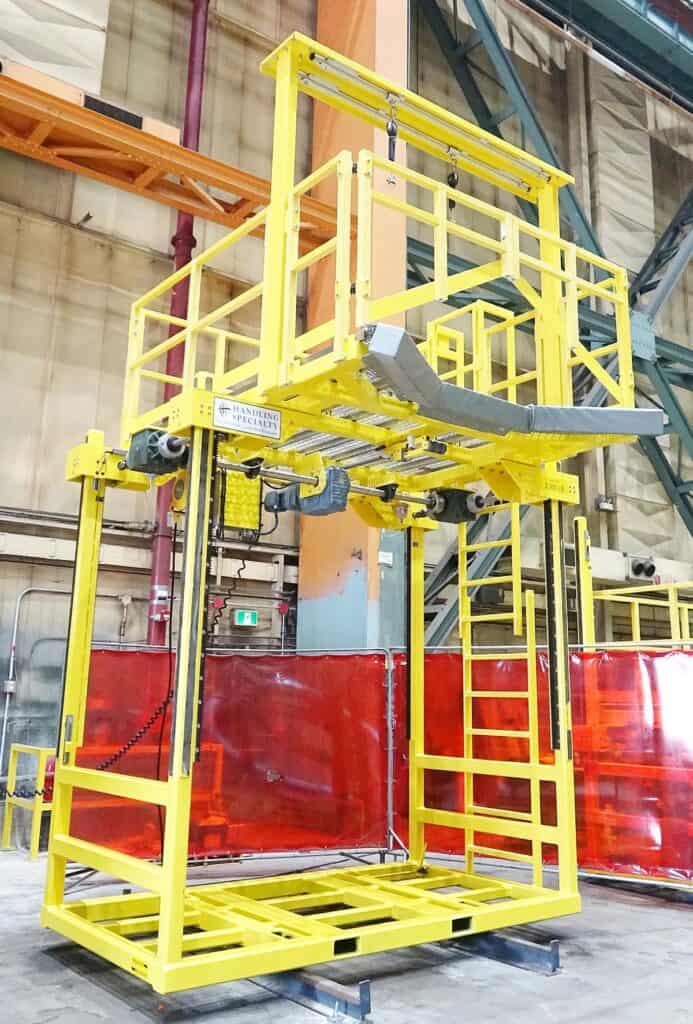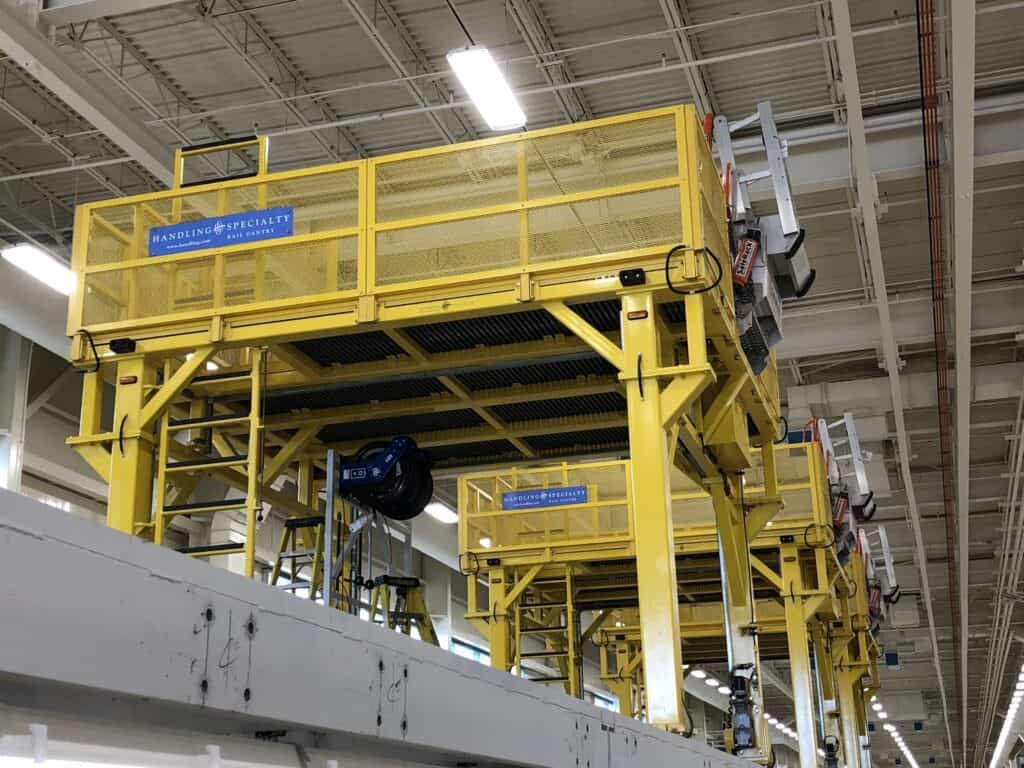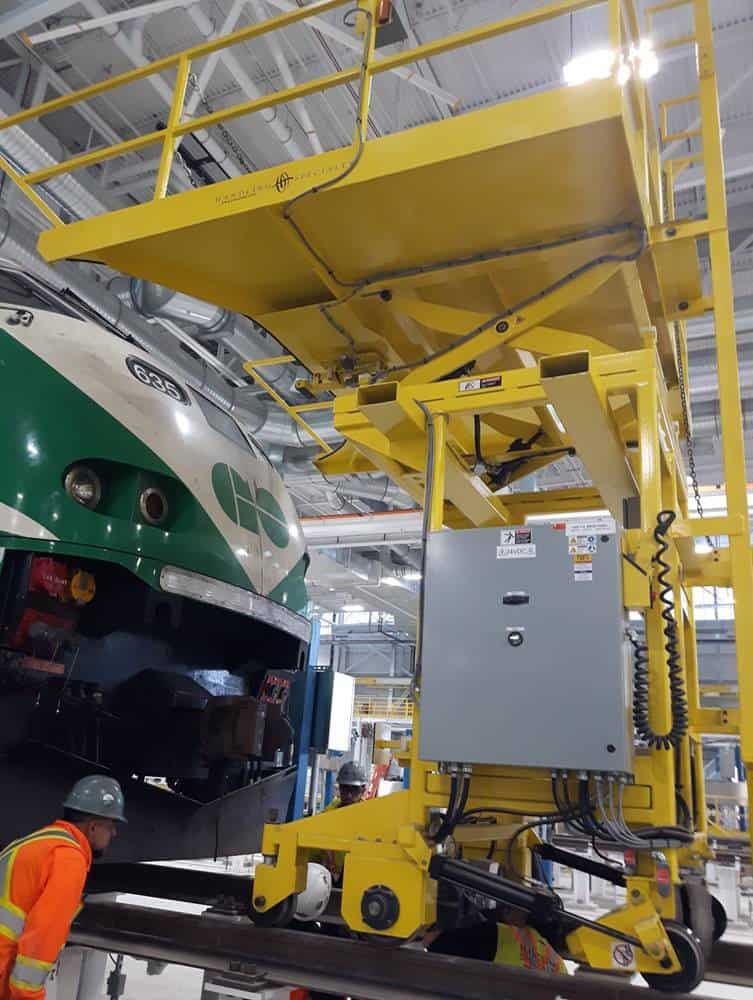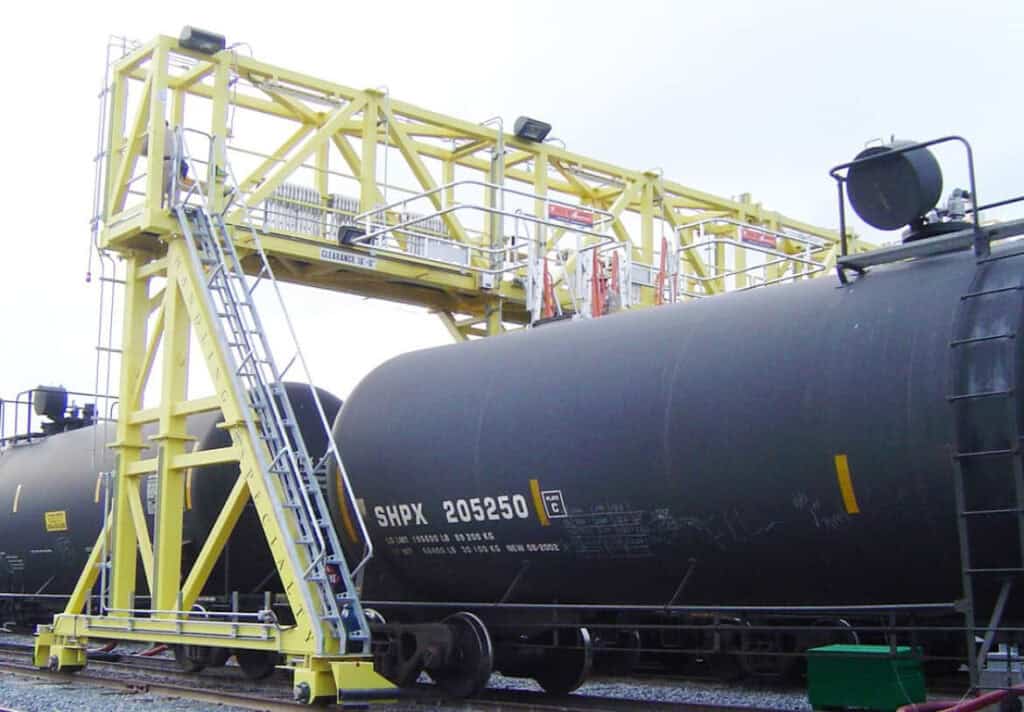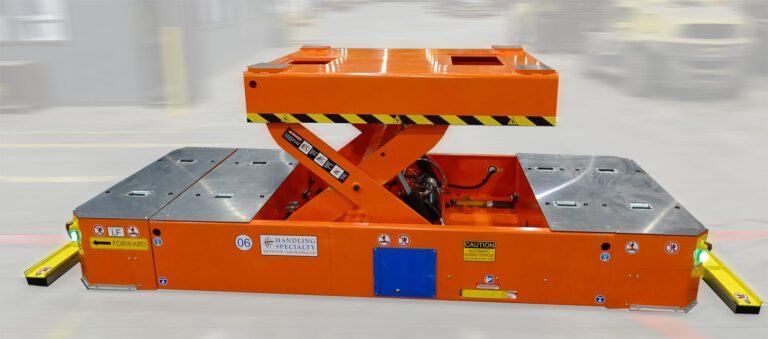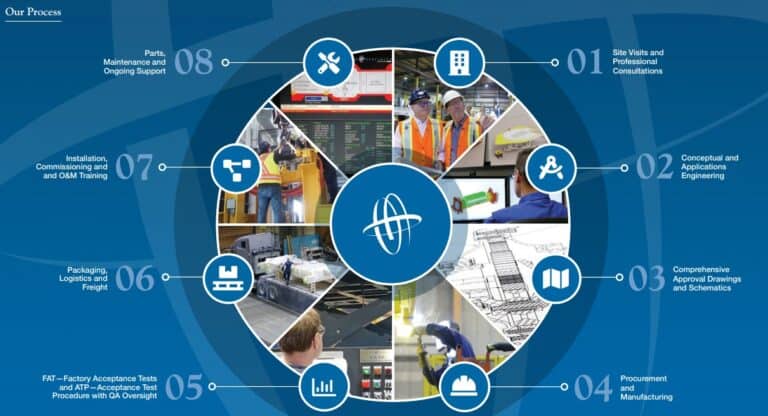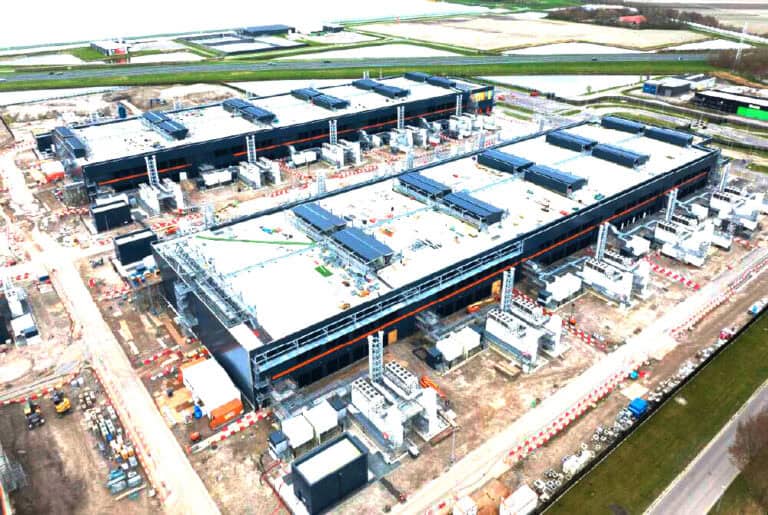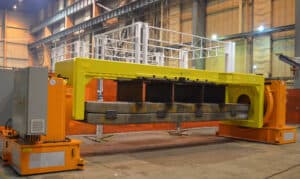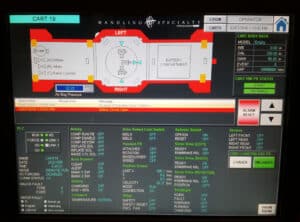Article Highlights
- Rail gantries are used in maintenance tasks. These rail material handling solutions ride on maintenance rails that run parallel to the main track.
- They feature key characteristics like adjustable height, articulating ladders, specialized tooling, motion control, and other important material handling requirements.
- Rail gantries may provide adjustable heights for different railcar models, ensuring flexibility and ease of use.
- They offer mobility and flexibility on tracks, making them suitable for heavy loads, jigs, and crane systems.
- Rail gantry cranes can support maintenance tasks, especially in outdoor applications and work areas.
Introduction
Rail gantries provide efficiency and convenience when it comes to lifting and moving heavy loads in various maintenance tasks. From rail yards to MRO facilities, they play a crucial role in ensuring smooth operations and minimizing downtime.
Understanding the basics of rail gantries is essential to harnessing their full potential. These rail MRO systems can be designed to have a fixed or adjustable height, allowing them to adapt to different maintenance tasks and railcar models. They are often equipped with wire rope hoists for easy and precise lifting and lowering of equipment such as roof-top AC units.
There are different types of rail gantries used in maintenance tasks. Custom rail gantries can provide a higher lifting capacity and are used in larger maintenance operations. These gantries can include single-girder cranes, which are compact, versatile and suitable for various maintenance applications.
Let’s discuss rail gantry’s importance in enhancing safety, reducing downtime, and improving efficiency in rail MRO operations. Additionally, we will look into case studies where rail gantries have been successfully used in maintenance operations. Finally, we will provide maintenance tips, discuss innovations in rail gantry technology, and provide guidance on choosing the right gantry for your rail maintenance needs.
Understanding Rail Gantries
These rail MRO solutions specialize in bringing technicians to the top of railcars and lifting equipment used in maintenance tasks. These gantries are designed to be mounted on tracks, providing mobility and flexibility in various work areas. They can have a fixed height or be adjustable, allowing them to accommodate different railcar models and working conditions. Rail gantries are sometimes equipped with wire rope hoists and trolleys, enabling them to lift and move heavy loads with ease and precision.
The Basics of Rail Gantry Operation
Rail gantries operate using maintenance tracks, allowing the platform to move above the railcars they will be working on. They will be fitted with reciprocating ladders or staircases to allow for ergonomic access to the railcar roof. The wire rope hoist is responsible for lifting and lowering the load while the trolley moves horizontally along the gantry beam. This combination allows for precise movement and positioning of the load during maintenance tasks.
Depending on the gantry’s design, the wire rope hoist is controlled using a pendant or a remote control. The operator can use these controls to control the lifting speed, direction, and positioning of the load. Safety features such as limit switches and overload protection are incorporated into the hoist system to ensure safe and efficient operation.
Motion controls are affixed to the platform so technicians can move the gantry along the maintenance tracks as they perform MRO operations on the rail cars. Custom rail car gantries often include a handheld version as well.
Rail gantries are designed to handle a wide range of loads and can be customized to meet specific maintenance requirements.
Types of Rail Gantry Cranes Used in Maintenance
Rail gantries are available in different types to suit various maintenance tasks. The choice of the gantry depends on the task’s specific requirements and the environment in which it will be used.
Bridge gantries are designed for larger maintenance operations that require higher lifting capacities. Bridge cranes provide excellent stability and lifting capabilities, making them suitable for heavy-duty maintenance tasks.
Tanker car gantries allow personnel to be positioned over the top of rail tanker cars in an outdoor environment. Two critical factors in developing these solutions were the safety of workers and the equipment’s ability to withstand a harsh outdoor environment. These self-propelled, custom rail gantries can span four railway lines, allowing personnel to access four rail tank cars simultaneously by using four pivoting and telescoping gangways.
Nosecone gantries allow easy access to the front of any locomotive design, allowing technicians to approach and work on the locomotive’s windshield and other aspects ergonomically.
Key Features of Efficient Rail Gantry Systems
Efficient rail gantry systems are equipped with several customizable features that enhance their performance and usability in maintenance tasks. These features include:
- Steel construction: Ensures durability and corrosion resistance in various environments.
- Extendable staircase or ladders.
- Jigs and crane systems.
- Swivel casters: Provide easy maneuverability and stability on different surfaces.
- Adjustable height: Allows for customization to accommodate various railcar models and working conditions.
- Wide range of load capacities: Enables the lifting and moving of heavy loads in maintenance tasks.
Adjustable Heights for Various Railcar Models
Rail gantries offer adjustable heights, allowing them to accommodate various railcar models and sizes. This feature is particularly beneficial in maintenance tasks where different railcars need to be serviced in the same facility.
The adjustable height feature enables the gantries to be easily adjusted to the required height, ensuring that the railcar is at a comfortable and safe working level. This eliminates the need for additional equipment or platforms to reach higher areas of the railcar.
With adjustable-height rail gantries, maintenance tasks such as inspections, repairs, and replacements can be carried out efficiently and effectively. The gantry can be easily maneuvered to the desired height, providing optimal access to different parts of the railcar.
Mobility and Flexibility on Tracks
Rail gantries are designed to be mobile and flexible on maintenance tracks, making them highly efficient in maintenance tasks. These gantries are equipped with features that allow them to move smoothly and easily along the tracks, even when carrying heavy loads.
Handling Specialty’s rail gantries are known for their exceptional mobility and flexibility. They can navigate extensively and reach difficult-to-access areas, making them ideal for maintenance tasks where precision and maneuverability are required.
Another significant advantage is the ability of rail gantries to handle heavy loads. They are designed to lift and move heavy machinery, equipment, and materials, ensuring that maintenance tasks can be completed safely, ergonomically, and efficiently.
The Importance of Rail Gantries in Maintenance Tasks
A rail gantry’s importance lies in its ability to provide safe and efficient solutions for handling personnel, equipment, and heavy loads and accessing hard-to-reach areas.
In outdoor applications, rail gantries are essential for carrying out maintenance tasks on railcars, machinery, and equipment. Their mobility and flexibility on tracks allow for easy movement and positioning, ensuring that maintenance can be performed effectively in any work area.
Maintenance tasks often require working at heights or in confined spaces, and rail gantries enable workers to access these areas safely and efficiently. They provide a stable and secure platform for carrying out inspections, repairs, and replacements, minimizing the risk of accidents and maximizing productivity.
Safety Enhancements with Proper Use
Proper use of rail gantries ensures safety during maintenance tasks and equips them with safety features that enhance the overall safety of operations.
One of the key safety features is the overhead crane system, which provides a secure suspension point for the hoist. This system ensures that the load is lifted and moved in a controlled manner, minimizing the risk of accidents or damage.
Safety rails are included on the perimeter of the platform to protect personnel and equipment from fall hazards. Gantries also include safety harness systems for added protection. The hoist itself is designed to meet strict safety standards, with features such as overload protection and emergency stop functions. These features prevent the crane from lifting beyond its capacity and allow for immediate stopping in case of emergencies.
Additionally, rail gantries are equipped with safety mechanisms such as limit switches and safety latches to ensure the safety of everyone and everything. Regular maintenance and inspections of the gantry and its components are recommended for optimal safety and performance.
Reducing Downtime During Maintenance
Rail gantries are highly efficient in reducing downtime during maintenance tasks. They can move personnel and products while handling heavy loads and provide easy access to different areas of a railcar’s roof, significantly speeding up the maintenance process.
The rail gantry cranes’ ton capacity allows for the lifting and moving of heavy machinery and materials, eliminating the need for manual labour or additional equipment. This reduces the time required to complete maintenance tasks and minimizes disruptions to MRO operations.
The span of rail gantry cranes also contributes to reducing downtime. With a wide span, the crane can cover a larger area, allowing for efficient movement and positioning. This ensures that maintenance tasks can be performed quickly and effectively, minimizing the time required for railcars to be out of service.
Case Studies: Rail Gantry Cranes in Action
Handling Specialty’s rail gantries have been successfully used in various countries around the world, including the USA and Canada. These case studies highlight the effectiveness of rail gantries in maintenance operations. Refer to three rail gantry MRO success stories below:
- Handling Specialty Manufacturing custom designed and manufactured a nose cone maintenance platform for a US high-speed rail organization.
- Handling Specialty was approached by a high-speed rail company in the United States to custom design and manufacture a personnel platform for maintaining trains inside three of its maintenance facilities in Washington, Boston and New York.
- Handling Specialty was approached by a company responsible for designing an oil trans-loading operation in New Orleans, Louisiana.
Efficiency Improvements in Rail Yards
Rail gantries have significantly improved efficiency in rail yards, particularly in maintenance tasks. These cranes have replaced manual labour with mechanical lifting capabilities, personnel placement, and ergonomics, reducing the time and effort required to handle heavy loads and perform MRO tasks.
By utilizing rail gantries in maintenance tasks, rail yards have experienced faster turnaround times for repairs and replacements. This means that railcars can be back in service more quickly, minimizing disruptions to rail operations. Rail gantries also support rail tanker loading and unloading in exterior applications.
In addition, rail gantries have improved the efficiency of HVAC maintenance in rail yards. The gantries easily lift and position HVAC units for inspection, repair, or replacement, ensuring that the systems are properly maintained and functioning optimally.
The use of rail gantry cranes in rail yards has proven to be a cost-effective solution by increasing the overall efficiency of maintenance operations.
Maintenance Tips for Rail Gantries
Here are some tips for maintaining a rail gantry:
- Regularly inspect its components for any signs of wear or damage. This includes checking attachments, wheels, gates, safety sensors and other important aspects.
- Lubricate moving parts, such as wheels and gears, to ensure smooth operation. Pay special attention to areas that are prone to friction or high levels of stress.
- Keep the work area and platform clean and free of debris or obstructions that could interfere with the unit’s operation.
- Conduct periodic load testing to ensure that the crane can handle its maximum rated capacity. This helps identify any potential issues or weaknesses in the crane’s structure or components.
By following these maintenance tips, rail gantry systems can continue to operate efficiently and safely, ensuring smooth and effective maintenance tasks.
Innovations in Rail Gantry Crane Technology
Innovations in rail gantry technology are driving advancements in maintenance tasks. These innovations aim to improve efficiency, safety, and overall performance. Here are some notable advancements:
- Automation: Automation technologies, such as motorized trolleys and remote controls, are being integrated into rail gantry systems. These advancements enable operators to control the crane’s movements with precision and ease, improving efficiency and reducing the risk of human error.
- IIoT: The Industrial Internet of Things is assisting companies with predictive maintenance on the rail gantry systems by including sensors that measure vibration and other wear and tear analytics.
By embracing these innovations, industries can expect to see significant improvements in maintenance tasks, resulting in increased efficiency, productivity, and safety.
Choosing the Right Rail Gantry Crane
Consider the following factors when selecting a rail gantry system:
- Machinery: Assess the weight and dimensions of the machinery or equipment that the gantry will be handling. Select a crane that has the appropriate lifting capacity and features to accommodate the specific requirements.
- Tasks: For maintenance tasks, consider a rail gantry system suitable for outdoor use and able to withstand harsh environments. Look for features such as corrosion-resistant materials and durable construction.
By carefully considering the specific needs of the maintenance tasks and the work environment, industries can choose the right rail gantry system that will fulfill their requirements and provide optimal performance.
Factors to Consider
When choosing a rail gantry crane, there are several factors to consider to ensure the best fit for your maintenance tasks. These factors include:
- Workstation: Assess the specific requirements of your maintenance tasks and determine the ideal features for your workstation. Consider factors such as adjustable height, span, and tread to ensure easy access and efficient operation.
- Wide Range: Rail gantry cranes come in a wide range of models and configurations. Consider the specific needs of your maintenance tasks, such as lifting capacity and size requirements, to choose the most suitable crane for your operations.
By considering these factors, you can select a rail gantry crane that meets your specific requirements and provides optimal performance in your maintenance tasks.
Comparing Different Models and Brands
it is important to consider the specific features and capabilities of your custom rail gantry system. Some factors to compare include:
- Design/build firms: a company like Handling Specialty Engineers builds your custom rail MRO gantry systems to your specific requirements. With over 60 years of experience, you want to choose a company that has the know-how and talent in place to design, build, and maintain your gantry system.
- Customization: This aspect of designing your gantry system is very important as it will improve the efficiency of your MRO operations when performing maintenance duties.
- Installation: A company that can offer turnkey solutions for your rail gantry system, including installation and training, will ensure proper working and maintenance conditions moving forward.
By comparing different models and brands, you can make an informed decision and choose the rail gantry system that best suits your maintenance task needs.
Conclusion
Efficient rail gantry systems are important in optimizing rail maintenance tasks. With their adjustable heights, mobility on tracks, and safety enhancements, these solutions streamline operations and reduce downtime. By conducting routine check-ups, identifying common issues promptly, and embracing innovations like IIoT, maintenance efficiency is significantly improved. Choosing the right system involves considering key factors and comparing models for optimal performance. Proper installation and team training are essential for safety and operational excellence. Embracing future trends in rail maintenance equipment ensures sustained efficiency and productivity in maintenance operations.
Frequently Asked Questions
What Maintenance Tasks Can Be Performed with a Rail Gantry Crane?
A rail gantry crane can perform a wide range of maintenance tasks, including lifting and moving heavy machinery, equipment, and materials. It provides the necessary stability, efficiency, and safety to carry out inspections, repairs, and replacements efficiently and effectively.
How Do Rail Gantry Cranes Enhance Safety During Maintenance?
Rail gantry cranes enhance safety during maintenance tasks by providing a stable and secure platform for working at heights or in confined spaces. Their safety enhancements, such as overhead crane systems and proper hoist use, ensure controlled lifting and minimize the risk of accidents or damage.
Contact our technical sales team for a conversation about your next rail gantry system

